


Samuel Palmer's father was a bookseller and later a Baptist minister in London, so the young Palmer received a very religious education. Already at the age of ten years he liked to paint passionately and a lot. At the age of fourteen he had his first public exhibition at the Royal Academy, although he did not enjoy a regular artistic education, but was self-taught. His great role model was William Turner, whose atmospheric paintings of sunsets, lunar landscapes, storms and rural idylls inspired him greatly at a young age. When he was twenty years old, he met the poet and painter William Blake through an acquaintance and this artist, described as a "pioneering figure in the history of English poetry", influenced Palmer's work even more lastingly. He bought a poor little house near Shoreham/Kent and painted there atmospheric landscapes, often in moonlight and sepia colours. The time spent in his cottage, often derisively called "Rat Abbey", was one of the most productive and best periods of his life. Well-known paintings from this time are "Cornfield in Moonlight with Evening Star" and "Into a Shoreham Garden". But Samuel Palmer also found his happiness here in private. He fell in love with Hannah Linnel, daughter of the painter John Linell, who was only twelve years old and was to become his wife seven years later.
At the age of thirty-five Palmer returned to London and it was here that the wedding with Hannah took place. As a husband and soon as a family man, the artist had to try to achieve financial success. Therefore he was forced to adapt to the spirit of the times, because his often mystical and idyllic oil paintings did not really sell well. So he increasingly painted watercolors, which were very fashionable in England at that time. He also gave private art lessons. On a trip to Italy, which the couple was financed by their father-in-law, they painted the very famous painting "A Dream in the Apennines". At this time he was also quite successful again, both with his landscapes and with his large watercolours to Milton's poems and with his etchings. When his oldest son Thomas died suddenly in 1861 at the age of only 19, Palmer never really recovered from the shock that hit him and his wife. But he lived in seclusion in Surrey for another 20 years.
After his death, Samuel Palmer was largely forgotten and his second son Alfred destroyed many of his works from the "Shoreham period", as well as sketchbooks and notebooks from his father's estate, because he thought they were worth nothing. Only over 50 years later the artist was rediscovered, so to speak. Precisely because many of his paintings no longer exist, the surviving paintings are highly sought after and often fetch prices of over 1 million US dollars at auctions.

Samuel Palmer's father was a bookseller and later a Baptist minister in London, so the young Palmer received a very religious education. Already at the age of ten years he liked to paint passionately and a lot. At the age of fourteen he had his first public exhibition at the Royal Academy, although he did not enjoy a regular artistic education, but was self-taught. His great role model was William Turner, whose atmospheric paintings of sunsets, lunar landscapes, storms and rural idylls inspired him greatly at a young age. When he was twenty years old, he met the poet and painter William Blake through an acquaintance and this artist, described as a "pioneering figure in the history of English poetry", influenced Palmer's work even more lastingly. He bought a poor little house near Shoreham/Kent and painted there atmospheric landscapes, often in moonlight and sepia colours. The time spent in his cottage, often derisively called "Rat Abbey", was one of the most productive and best periods of his life. Well-known paintings from this time are "Cornfield in Moonlight with Evening Star" and "Into a Shoreham Garden". But Samuel Palmer also found his happiness here in private. He fell in love with Hannah Linnel, daughter of the painter John Linell, who was only twelve years old and was to become his wife seven years later.
At the age of thirty-five Palmer returned to London and it was here that the wedding with Hannah took place. As a husband and soon as a family man, the artist had to try to achieve financial success. Therefore he was forced to adapt to the spirit of the times, because his often mystical and idyllic oil paintings did not really sell well. So he increasingly painted watercolors, which were very fashionable in England at that time. He also gave private art lessons. On a trip to Italy, which the couple was financed by their father-in-law, they painted the very famous painting "A Dream in the Apennines". At this time he was also quite successful again, both with his landscapes and with his large watercolours to Milton's poems and with his etchings. When his oldest son Thomas died suddenly in 1861 at the age of only 19, Palmer never really recovered from the shock that hit him and his wife. But he lived in seclusion in Surrey for another 20 years.
After his death, Samuel Palmer was largely forgotten and his second son Alfred destroyed many of his works from the "Shoreham period", as well as sketchbooks and notebooks from his father's estate, because he thought they were worth nothing. Only over 50 years later the artist was rediscovered, so to speak. Precisely because many of his paintings no longer exist, the surviving paintings are highly sought after and often fetch prices of over 1 million US dollars at auctions.
Page 1 / 5








